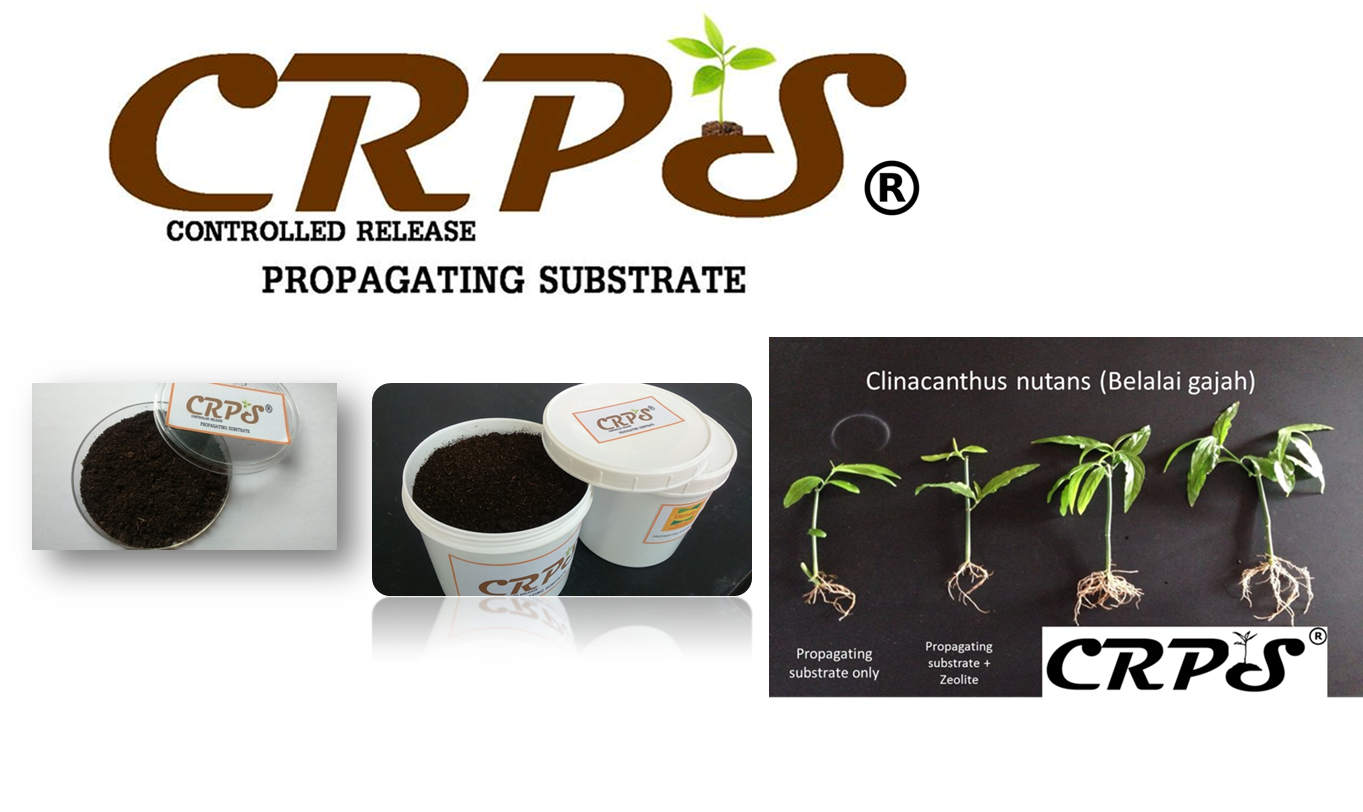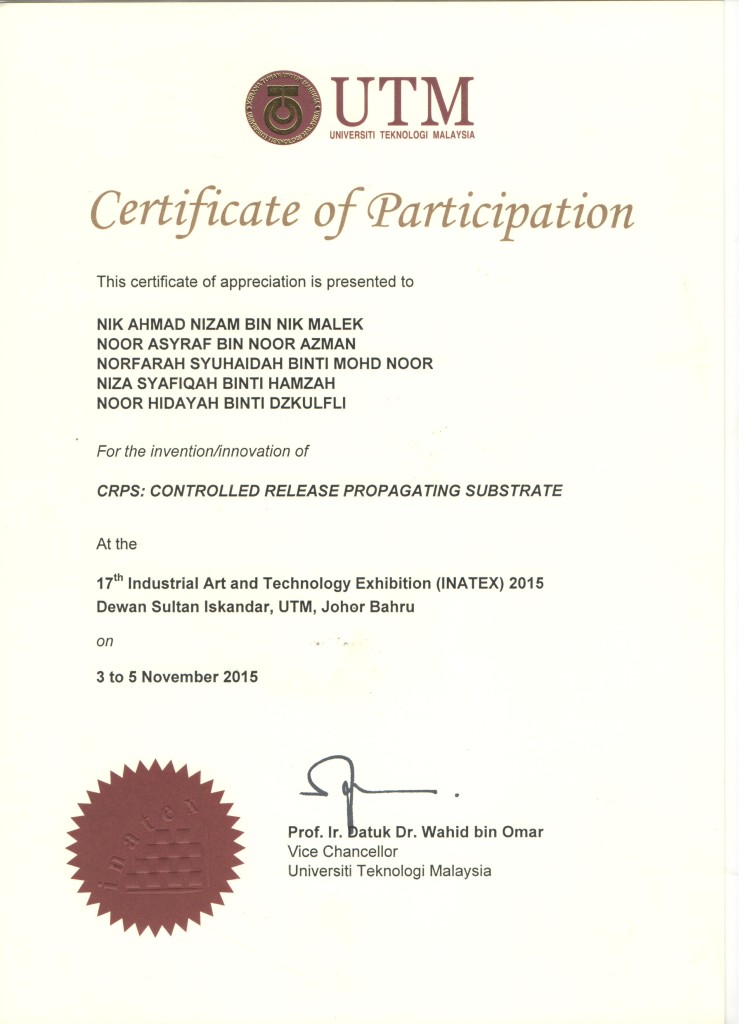CRPS: CONTROLLED RELEASE PROPAGATING SUBSTRATE
Brief Summary
Nowadays, soil has been substituted with propagating substrate as a medium for sowing purposes. The soilless sowing technique (propagating substrate) is recommended by using organic rich growing medium such as coco peat and biomasses. The commercial propagating substrates are usually added with other substances to provide nutrients in order to increase the propagating rate. However, the problem rise when the nutrients are leached out from the propagating substrates and thus, decrease the nutrients contains in the substrate in a long term and eventually, decrease the plant yield. This problem can be overcome by the addition of zeolite which is a natural mineral obtained from volcanic area. The unique properties of zeolite, i.e. high cation exchange capacity, high surface area, crystal forms, etc. allow the nutrients to be retained in the substrates and slowly release the nutrients. However, the zeolite has limitation where it can only adsorb and retain cationic nutrients such as NH4+ or K+ but not anionic compounds such as PO43-. P element mainly exists in the form of phosphate anion is very crucial in the propagating substrate especially for the plant root development. Fortunately, this limitation can be overcome by the addition of surfactant modified zeolite (SMZ) in the propagating substrate since the SMZ is proven having the capability in adsorbing cationic and also anionic compounds. Therefore, our product called CRPS® (Controlled Release Propagating Substrate) is the propagating substrate that has been added with SMZ in an optimal amount.
The process of making CRPS® has been filed for patent with the PI No: PI 2014702589. The concept that has been explained earlier has been proven in our laboratory and field studies. It was proven that the addition of the right amount of SMZ in the propagating substrate decreased the amount of all major nutrients (N, P and K) released compared to that of the addition with only zeolite. Our studies also proved that the plant growth was higher in the CRPS® compared to propagating substrate added zeolite and only propagating substrate.
We believe that the usage of CRPS® replacing soils and other growing media could benefited in two ways: (1) save our environment, (2) high yield of plants. The targeted customers are the agriculture companies involve in growing the plants, nurseries and also big companies and agencies such as FELDA, Sime Darby, FELCRA etc. The product is essential for those involve in plantation because they can preserve our environment for the future by avoiding the release of the huge amount of nutrients that can contaminates our soils and water. Because of this, they can preserve the land in a long term and decrease the cost of fertilizer or soil treatments.
The development of this product has been funded by Sciencefund project funded by Ministry of Science, Technology and Innovation (MOSTI) (project No: 06-01-06-SF0994). Now, the product is now ready for pre-commercialization stage. We are looking for the companies that can invest in the production, marketing and selling this product.
PRODUCT FEATURES
| Product name | CRPS® : Controlled Release Propagating Substrate |
| Application
|
Propagating substrate, growing medium |
| Need |
The soilless medium that replacing soil have been used for sowing purposes. It is used as propagating substrate or growing medium for the seed before transplant to soil or bigger pots. The typical commercial propagating substrate usually comprises of coco peat and also some essential plant nutrients. These nutrients are added physically with the coco peat and they can easily leached out from the substrate. The leaching of nutrients especially during the watering process will remove some of the nutrients and decrease the plant nutrients availability in the substrate. The leaching of nutrients also can affects soils and underground water which eventually, gives bad effect to the environment. |
| Approach |
The leaching of nutrients from the propagating substrate can be achieved by the addition of a carrier system that can hold and retain the essential nutrients. One of the carrier system is surfactant modified zeolite which is the zeolite (mineral from volcanic area) that has been attached with suitable amount of surfactant. The surfactant modified zeolite is capable in retaining and holding various forms of nutrients either in cationic or anionic forms, where zeolite has limitation for the anionic form. Therefore, this product called CRPS®, is a controlled release propagating substrate is proven to have the ability in releasing the nutrients at the slower rate and also gives high yield to the plant. |
| Benefits |
By using CRPS® as the soilless medium for sowing and propagating purposes, the seed will grow in a short period because the essential nutrients are preserved in the substrate unlike the raw substrate. The plants will have enough nutrients to grow before transplant to soil or other container. Therefore, the usage of CRPS® will enhance the productivity of the farmers and furthermore, promoting to a sustainable agriculture approach. |
| Competition |
There are no similar product have been found in market so far. However, the product will compete with the controlled release or slow release fertilizer that usually added together in the substrate. However, the purpose of this fertilizer is to provide nutrients slowly but not the hold and retain the existing nutrients in the substrate. |
PRODUCT FACTS
| ITEMS | DOCUMENTATION |
| Patents | Nik Ahmad Nizam Nik Malek, Noor Hidayah Dzkulfli, Niza Syafiqah Hamzah (2014). Controlled Release Propagating Substrate. PI 2014702589. |
| Trademark Logo | Registration No: 2014 065417 (Class 1) |
| Design Machine for Large Scale production | Proposal No. FKP 2014-2, Proposal for machine for large scale production by Faculty of Manufacturing Engineering, Universiti Teknikal Malaysia Melaka (UTeM), Melaka. (09 Oct 2014) |
| Research Grants | 1. Sciencefund, Ministry of Science, Technology and Innovation Malaysia (MOSTI), Development of Organo-Zeolite as Advanced Controlled Release Fertilizer. 01/08/2012–31/01/2015. RM 254,600.00. Vot No: 4S038
2. Research University Grant (RUG), UTM, Tier 2. Nanozeolites from Rice Husk Ash as Nanofertilizer. 01/12/2012–30/12/2013. RM 32,000.00. Vot. No: 07J45 |
PROOF OF CONCEPT
| ITEMS | DOCUMENTATION |
| Theses | 1. Noor Hidayah Bt Dzulkfli (2012-2015). Application of Modified Clinoptilolite in the Growth of Clinacanthus nutans. MSc (Biosciences). FBME, UTM, Research Student Grant (RSG) from Sciencefund (4S038).
2. Haryani Abdullah (2014-2015). The Study of Controlled Release Propagating Substrate (CRPS) and NPK-Organo-Zeolite Performance on Clinacanthus nutans. MSc (Biotechnology) (Mixed Mode, FBME, UTM). 3. Loo Yan Jie (2014-2015). Effect of Surfactant-Modified Zeolite (SMZ) Added in Propagating Substrate for the Germination of some Vegetables. Final Year Undergraduate Project, BSc (Industrial Biology), FBME, UTM. |
| Scientific Articles | 1. Noor Hidayah Dzkulfli, Niza Syafiqah Hamzah, W Mohd Madhi W Abdullah, Nik Ahmad Nizam Nik Malek, Salehuddin Hamdan. Effect of Surfactant Modified Clinoptilolite added Propagating Substrate in the Growth of Clinancanthus nutans. 2nd International Science Postgraduate Conference 2014 (ISPC 2014), Institute Ibnu Sina for Fundamental Science Studies, UTM, 10-12 Mar 2014.
2. Loo Yan Jie, Nik Ahmad Nizam Nik Malek. Effect of Surfactant-Modified Zeolite (SMZ) Added in Propagating Substrate for the Germination of some Vegetables. Biosciences and Medical Engineering Students Conference (BME15), FBME, T02 UTM, Johor, 26-27 May 2015 3. Loo Yan Jie, Nik Ahmad Nizam Nik Malek, Teo Wee Siang Niza Syafiqah Hamzah, Noor Hidayah Dzkulfli. Effect of Surfactant Modified Zeolite (SMZ) Added in Propagating Substrate for the Germination of Some Vegetables. In Proceedings of The IRES – 2nd International Conference on Food and Agricultural Engineering (ICFAE), Page 88-92, ISBN: 978-93-85465-56-7, Flamingo by the lake, Kuala Lumpur, 16 July 2015. |
COMMERCIALIZATION APPROACHES
These are the methods to commercialize products under UTM suggested by Innovation and Commercialization Centre (ICC-UTM) and needs to follow the “UTM Intellectual Property Commercialization Policy”.
| OPTION | DESCRIPTION |
| Spin-off / joint-venture companies
|
· Third parties investments into UTM’s patent to enable the most effective commercialization of the product.
· Spin-off type A: UTM has equity and receives up-front payment and royalties · Spin-off type B: UTM will receive only upfront payment and royalties.
|
| Commercialization project
|
· Small commercialization project for production and commercialization of CRPS® by any interested companies.
|
| Licensing | · Manufacturing and marketing CRPS® by any interested company. In return, UTM and inventor will get a royalty for the selling item.
|
ACKNOWLEDGEMENTS
- Ministry of Science, Technology and Innovation Malaysia
- Provet Group of Companies Sdn Bhd, Serdang, Selangor
- Bioprospect Sdn Bhd, Kluang, Johor.
- MARDI, Pontian, Johor
- Faculty of Manufacturing Engineering, Universiti Teknikal Malaysia Melaka (UTeM)
- Mineral Research Centre (MRC), Mineral and Geoscience Department Malaysia.
- Universiti Teknologi Malaysia (UTM)
- Faculty of Biosciences and Medical Engineering, UTM
- Centre for Sustainable Nanomaterials (CSNano)
- Nanotechnology Research Alliance, UTM
- Research Management Centre (RMC), UTM
- Innovation and Commercialization Centre (ICC), UTM
- Frontier Materials Research Alliance, UTM



